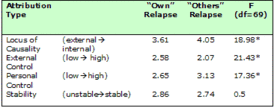Series Special Editor:Sarah E. Nelson
Your hectic schedule has left no time for lunch and now you’re starving. As you’re being rushed into yet another meeting, you notice someone has left freshly baked cookies on their desk. It calls out to you. You swipe the cookie just as a co-worker passes by. She clicks her tongue disapprovingly. In your own mind, your actions were a product of the situation you found yourself in. But your coworker sees it differently: she attributes your actions to personal dishonesty. This tendency to attribute our own behavior to situational causes and the behavior of others to personal factors is called the actor-observer effect (Jones & Nisbett, 1972). The differences between the attributions that actors (i.e., the person performing the behavior) and observers (i.e., people watching the actor) make about the causes of actors’ behavior can in turn lead to different judgments of responsibility, blame, and character. Applied to the field of addictions, this theory suggests that people might attribute their own relapse to stressful situations, while attributing other people’s relapse to personal attributes, such as a lack of willpower. This WAGER reports on a study by Seneviratne and Saunders (2000) that examined whether alcohol-dependent subjects make different inferences about the causes of their own relapse than those of another person’s relapse.
The researchers recruited 71 subjects from 5 in-patient drug treatment centers in Perth, Australia. All patients were over 18, met DSM-IV criteria for alcohol dependence, and did not meet the criteria for any major psychiatric disorders. Within the last 3 months, all subjects had voluntarily abstained from alcohol use for at least 4 days before relapsing. At the time of interview, subjects had completed detoxification and were receiving in-patient care. Subjects completed the Revised Casual Dimension Scale (McAuley, Duncan, & Russell, 1992) to first evaluate their “own” relapse and then four written relapse scenarios about “other” people. They rated the factors contributing to each relapse on locus of causality (i.e., whether the causes are external or internal), external control (i.e., whether the causes are things other people have control over), personal control (i.e., whether the causes are things they have control over) and stability (i.e., whether the causes are temporary or permanent). Each attribution dimension was rated on a scale from 1-5. The researchers hypothesized that alcohol-dependent subjects would attribute their own relapses to external, unstable causes while attributing the relapse of others to internal, stable causes with high personal control.
Table 1. Ratings of “Own” and “Other’s” Relapse on Four Attributional Dimensions
*p<.0001
Subjects made significantly different attributions for their own relapses as compared to the relapse of others. Alcohol-dependent subjects were less likely to attribute their own relapse to something inside of themselves and more likely to believe that their relapse was influenced by external situations outside of their control (reflected by ratings of 2.58 and 2.07 respectively; Table 1). Subjects were quicker to assign responsibility for other people’s relapse to a lack of personal control (reflected by ratings of 3.13 for others and 2.56 for their own relapse on this dimension). These differences between actor and observer attributions were robust – the same patterns existed for all four “other relapse” scenarios when compared separately, as well. Despite the differences in ratings, subjects viewed all of the relapses as primarily a function of internal causes, not external causes (mean scores of 3.61 for own and 4.05 for others’ relapse). Finally, subjects rated the cause of their relapse, as well as the relapse of others, as somewhat temporary and changeable (mean scores of 2.86 and 2.74 respectively).
The design of the study might have contributed to the relatively small differences observed between the actor and observer explanations of relapse. As a proxy for observing another person’s relapse, the researchers provided written stories. However, observing a relapse and reading about one is very different and might bias results away from internal explanations. In real time, observers might not be aware of external factors but can’t miss the external factors when they are spelled out explicitly in a written story. Further, clients requiring in-patient detoxification might represent an extreme compared to most people who relapse. Due to the severity of their relapse, this group might be more motivated to examine the internal mechanisms that contributed to their relapse. Finally, we can not rule out the possibility that the participants’ relapse might really have had more external causes. Future studies should employ independent judges for a comparison.
This study provided insight into the way people explain their own relapses. Although the researchers found evidence of an actor-observer difference, explanations for the subjects’ own relapses were more internal than predicted (and more internal than observed in most studies of actor-observer differences — see Ross & Nisbett, 1991). This might indicate that people with addictions view their internal cravings and urges as playing a much larger role in relapse than do external high-risk situations. Although patients see their actions as originating internally, they might still view them as uncontrollable. While strategies to avoid high-risk situations should continue to be a mainstay of treatment, treatment efforts might expand their focus on understanding the internal processes that lead to urges and relapse behaviors.
Comments on this article can be addressed to Rachel Kidman.
References
Jones, E. E., & Nisbett, R. (1972). The actor and the observer: Divergent perceptions of causality. In E. E. Jones, D. E. Kanouse, H. H. Kelley, R. Nisbett, S. Valins & B. Weiner (Eds.), Attribution: Perceiving the causes of behavior (pp. 79-94). Morristown, NJ: General Learning Press.
McAuley, E., Duncan, T. E., & Russell, D. W. (1992). Measuring causal attributions: The Revised Causal Dimension Scale (CDSII). Personality and Social Psychology, 18, 566-573.
Ross, L., & Nisbett, R. (1991). The person and the situation: Perspectives of social psychology: McGraw Hill Publishers.
Seneviratne, H., & Saunders, B. (2000). An Investigation of Alcohol Dependent Respondents’ Attributions for Their Own and "Others" Relapses. Addiction Research, 8(5), 439
453.





